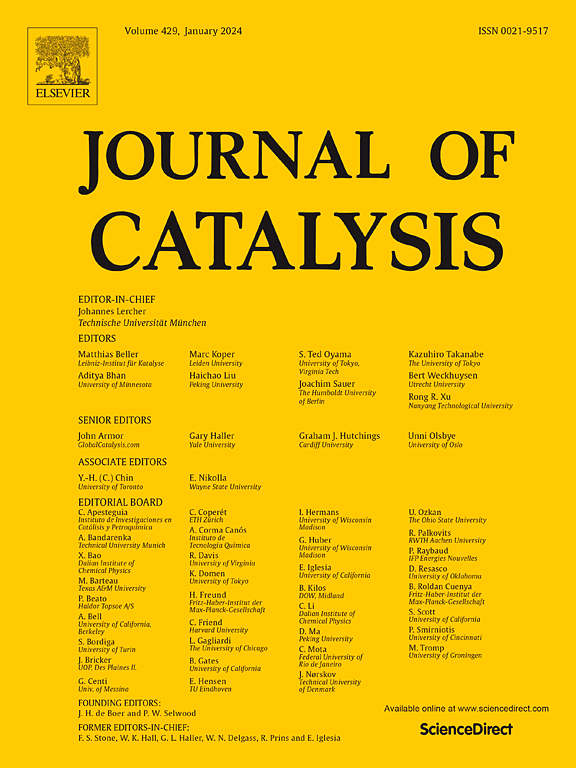Unparalleled dimerization of trans-2-butene to 3,4-dimethyl-1-hexene on iron-based catalyst
IF 6.5
1区 化学
Q2 CHEMISTRY, PHYSICAL
引用次数: 0
Abstract
Trans-2-butene is regularly burned as a liquefied petroleum gas (LPG) component in several developing countries due to its inertness and inseparability in comparison to other butene isomers (1-butene and isobutene), resulting in low-value utilization of resource and environmental degradation. The generation of high-carbon olefins via trans-2-butene oligomerization has become one of the most effective ways for its high-value valorization. Octene is currently undersupplied via ethylene oligomerization, and its traditional crafts are costly due to separation from full-fraction α-olefins (C4-C30). In the present work, we synthesized a series of novel 2-phenyl-ketimine-1,10-phenanthroline iron complexes (Fe0-Fe9). Fe2 catalyst realizes the dimerization of trans-2-butene through homogeneous catalysis at moderate conditions (0.2 MPa, 30 °C), obtaining 3,4-dimethyl-1-hexene with 99.9 % selectivity. In contrast to the reported heterogeneous catalysts, our catalytic system exhibits a considerable improvement in activity and selectivity.


铁基催化剂上反式2-丁烯到3,4-二甲基-1-己烯的无与伦比的二聚化
由于反式-2丁烯与其他丁烯异构体(1-丁烯和异丁烯)相比具有惰性和不可分离性,因此在一些发展中国家经常作为液化石油气(LPG)成分燃烧,导致资源的低价值利用和环境退化。反式-2-丁烯低聚制备高碳烯烃已成为其高价值增值的最有效途径之一。通过乙烯低聚反应得到的辛烯目前供应不足,而传统工艺由于需要从全馏分α-烯烃(C4-C30)中分离而成本高昂。在本工作中,我们合成了一系列新的2-苯基氯胺酮-1,10-菲罗啉铁配合物(Fe0-Fe9)。Fe2催化剂在中等条件下(0.2 MPa, 30 ℃)均相催化,实现了反式2-丁烯的二聚化,得到选择性为99.9 %的3,4-二甲基-1-己烯。与报道的非均相催化剂相比,我们的催化体系在活性和选择性上都有很大的提高。
本文章由计算机程序翻译,如有差异,请以英文原文为准。
求助全文
约1分钟内获得全文
求助全文
来源期刊

Journal of Catalysis
工程技术-工程:化工
CiteScore
12.30
自引率
5.50%
发文量
447
审稿时长
31 days
期刊介绍:
The Journal of Catalysis publishes scholarly articles on both heterogeneous and homogeneous catalysis, covering a wide range of chemical transformations. These include various types of catalysis, such as those mediated by photons, plasmons, and electrons. The focus of the studies is to understand the relationship between catalytic function and the underlying chemical properties of surfaces and metal complexes.
The articles in the journal offer innovative concepts and explore the synthesis and kinetics of inorganic solids and homogeneous complexes. Furthermore, they discuss spectroscopic techniques for characterizing catalysts, investigate the interaction of probes and reacting species with catalysts, and employ theoretical methods.
The research presented in the journal should have direct relevance to the field of catalytic processes, addressing either fundamental aspects or applications of catalysis.
 求助内容:
求助内容: 应助结果提醒方式:
应助结果提醒方式:


